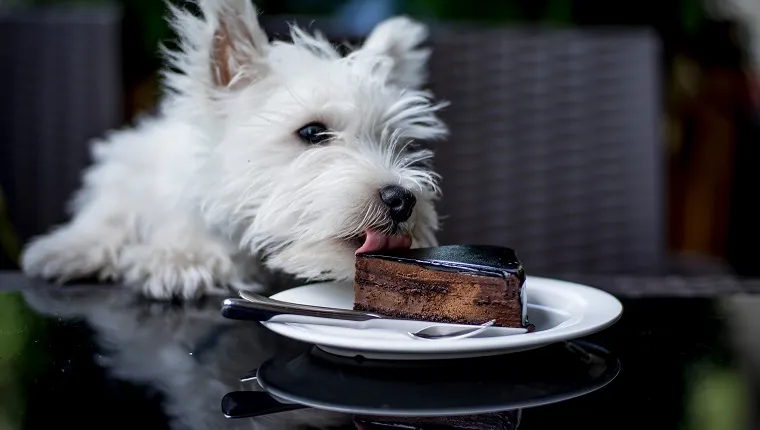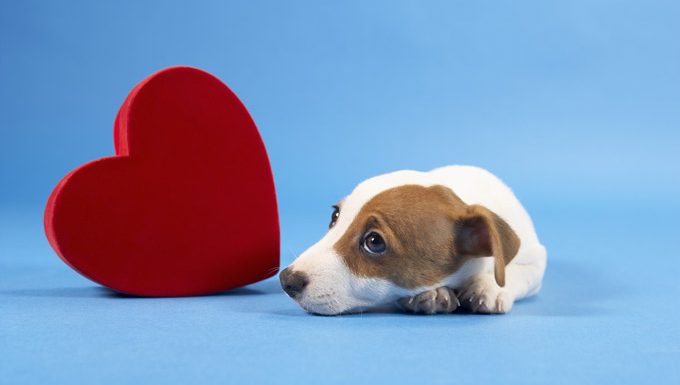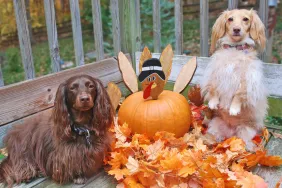Valentine’s Day is more than just the most romantic holiday of the year. From accessories, chocolates, jewelry, flowers, to — yes — undergarments, pets will likely enjoy your Valentine’s gifts and treats just as much as you do, but with some potentially serious health consequences.
Nobody wants to spend Valentine’s Day at the emergency vet. So make sure the love of your life, your furry friend, stays out of harm’s way.
Here are a few ways to keep your pet safe on Valentine’s Day.
Be Careful With The Candy
From those pastel-colored conversation hearts, to heart-shaped gummies, to red-and-pink jellybeans, Valentine’s Day is often all about the candy. But keep Fido and Fluffy at a distance while you enjoy these sweet treats.
Many varieties of sugar-free gum and sugar-free candy contain a sugar substitute compound called xylitol, a polyalcohol compound that is extremely toxic to your dog.
While xylitol is generally safe for human consumption, it can affect insulin levels in dogs and cause blood sugar levels to decrease sharply. In some cases, xylitol can cause liver failure, seizures, and even death.
Especially Keep The Chocolate Candy Away

Chocolate is packed with high amounts of fat and, even worse for Fido, caffeine and methylxanthines like theobromine, a stimulant that can be dangerous to dogs when eaten.
These stimulants can cause vomiting, diarrhea, accelerated heart rate, rapid breathing, tremors, high blood pressure, and even seizures, respiratory failure, and cardiac arrest.
Typically, the darker and more bitter the chocolate, the more dangerous the candy will be for four-legged friends. And the smaller the dog, the less chocolate it will take to cause some serious health issues.
In one Valentine’s Day case, a Labrador Retriever from British Columbia ate a whopping two pounds of fudge and milk chocolate suckers, enough sugar to irritate a stomach ulcer and put the chocolate-loving Lab in danger. Her humans rushed her to the vet, and their pet insurance company shelled out $3,696.20 to cover the cost of diagnosis and treatments.
Before you head out for your romantic Valentine’s Day date, take a second to look at the petMD Chocolate Toxicity Meter, which breaks down the theobromine and caffeine levels in a handful of common candies and other chocolate products you might have lying around the house this holiday.
Avoid Poisonous Blooms & Toxic Plants

We don’t just have our canine pals to look after this Valentine’s Day.
Is your special Valentine also a cat lover? Then the best way to say, “I love you” is to send only pet-safe bouquets that contain absolutely no plants of the Lilium or Hemerocallis species — that means no lilies.
Whether Tiger, Asiatic, Easter, Day, or Japanese Snow Lily, eating just one or two leaves, petals, or even enough pollen in any of these and other lily varieties can result in rapid kidney failure in felines.
Peace, Peruvian, and Calla lilies don’t necessarily cause kidney distress but can severely irritate a cat’s mouth and throat. While the exact toxic compound is unknown, according to the Pet Poison Helpline, the toxin is water soluble and found in all parts of the lily plant, from the stem to the petals and from the leaves to the bulb.
Signs of lily poisoning include vomiting, dehydration, lethargy, excessive thirst or, conversely, not drinking, or a change in urination levels. That usually means urinating too frequently or not urinating at all.
There is no cure for lily poisoning. However, it is vital that cats receive veterinary treatment as soon as possible after ingesting any amount of this plant. Cats will need close monitoring, IV fluids, and other supportive treatments in order to improve chances of survival.
And roses might be beautiful, but those thorns can sure be sharp. Dogs or cats who ingest this Valentine’s Day favorite can end up with serious problems. They could suffer abrasions and punctures of the mouth, throat, stomach, or intestines, resulting in infection, internal bleeding, or worse.
Pets Will Love Your Sparkly Gifts — To Munch On
You might think no one could be as excited as you to receive a piece of jewelry this Valentine’s Day. However, your pet could be eyeing that shiny bauble with much different intentions. Maybe they think it’ll taste as delicious as it is beautiful.
A simple internet search yields thousands of stories of dogs eating engagement and wedding rings, complete with x-ray images of dog stomachs with diamond rings inside.
Avoid that hassle and potential expensive surgeries to remove pieces of jewelry that don’t pass naturally. It’s best to keep that new sparkler safely away from Fido’s drooly chompers.
But accidents do happen. If you suspect your pooch has swallowed a piece of jewelry, contact your veterinarian immediately.
Undergarments Can Become Edibles To Dogs

It might sound silly, and it may be embarrassing to talk about, but many dog parents know this from experience — dogs love to chew on undergarments.
One pet insurance company paid $1,111.06 towards an x-ray and exploratory surgery after a Washington woman’s Pomeranian–Poodle mix ingested some of her unmentionables a few years ago. Sure enough, the vet discovered the pint-sized pup had consumed a pair of medium-sized ladies underwear.
When you’re not wearing it this Valentine’s Day, keep your lingerie on lockdown. Also, keep your panties in the hamper, and your drawers in your, well, drawers.
What other tips do you have to keep dogs safe on Valentine’s Day? Are you doing anything special with your dog? Let us know in the comments below!









